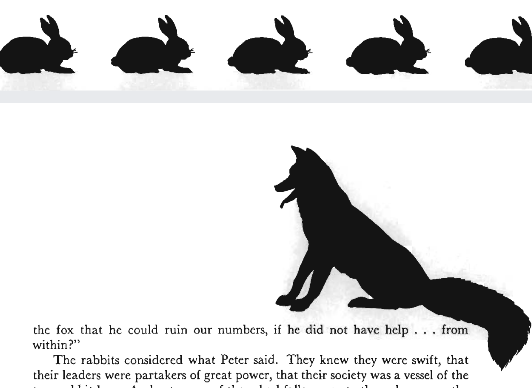Articles/Essays – Volume 16, No. 4
Feeding the Fox: A Parable
“Many religious people are deeply suspicious. They seem—for purely religious purposes, of course—to know more about iniquity than the Unregenerate.”
Rudyard Kipling, Witches of the Night
When the rabbits built Hilltown, they had a special sort of place in mind.
The rabbits had lived too long in fear of the fox. They were weary of foraging with an ear always to the wind, ever cautious of the fox’s red presence. They wanted a safe place where only rabbits would be allowed to live.
Peter, Chief Warren Contractor and a long-time investigator of the fox’s secret places, said a safe dwelling such as the rabbits hoped was possible. And Peter—who was respected for his seasonal services—was believed.
So, Hilltown was built. In a valley.
“Hilltown need not be on a mountain top to be safe,” Peter explained, “because our greatest danger is not the fox without but the fox within. I can build the warrens deep enough, design the entrances narrow enough, construct the passages as maze enough to confuse and discourage the fox in the field. But what can protect us against the enemy we build in, the traitor in our midst?”
The rabbits had no answer to such a question. The rabbit community was small, and the rabbits knew one another well; they had always thought of each other as brothers and sisters. The possibility of a brother or sister being an “enemy” would not have occurred to them, had not Peter suggested it.
“How many of us were lost to the fox during the past harvest season?” Peter asked.
The rabbits thought. There had been John, and Three-Toe-Strummer, and Long Ellen, and Drifter, and Sam, and . . . there had been quite a few.
“Yes,” Peter solemnly intoned. “There have been many. Too many. Are we so slow? Are our leaders so uninspired? Are we so ignorant of the ways of the fox that he could ruin our numbers, if he did not have help . . . from within?”
The rabbits considered what Peter said. They knew they were swift, that their leaders were partakers of great power, that their society was a vessel of the true rabbit lore. And yet many of them had fallen prey to the red menace, the ever-rapacious fox. Perhaps . . . .
“Perhaps,” Peter continued, “we are not all brothers and sisters, truly. Perhaps the fox is among us.”
And so it began: the building of Hilltown in the valley. A safe place.
At least, safe for most.
Peter told the rabbits it was inevitable that a few would suffer for the safety of the many. He explained the inevitable economy, the price of peace. And the rabbits agreed that whatever the price, the fox had to be discovered.
Discovery had been easy in the past. The fox was red and long. If a rabbit were cautious and kept an ear to the wind, the fox could be heard moving through the tall grass by the river, flattening the weeds beyond the bank where he crouched. If a rabbit listened, he could hear the movement in the air and know the fox was near.
But if the fox could be a rabbit, how could any rabbit be safe?
More subtle means of detection had to be employed. If you could not recognize a fox for what he did—if not all foxes ate rabbits—you had to establish other tests. For instance, if a rabbit disagreed with you, or did not understand the warren’s past as you did, or questioned Peter’s authority or theories, perhaps that rabbit was the fox. And since there was no longer any sure way of knowing the fox, being “perhaps” the fox was enough.
Enough for a rabbit to be called before Peter and purged. Cast out of Hill town. Being “perhaps the fox” became sufficient reason to be returned into the world and company of the fox.
At one point a rabbit asked: “But if these foxes do not eat us — if they behave as though they were rabbits, even though we do not agree with them — where is the harm? Why must they be cast out?” But Peter decided only a fox would ask such a question, and the questioning rabbit was cast out, too.
Leaving Hilltown finally safe in its valley.
And the fox well fed.


 Back to full Issue
Back to full Issue

